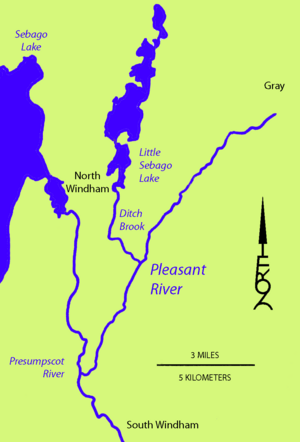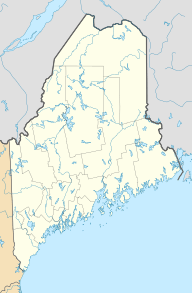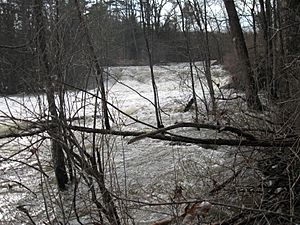Pleasant River (Presumpscot River tributary) facts for kids
Quick facts for kids Pleasant River |
|
|---|---|

The Pleasant River meets Ditch Brook near the U.S. Route 302 bridge
|
|
 |
|
| Country | United States |
| State | Maine |
| Region | Cumberland County |
| Physical characteristics | |
| Main source | Gray, Maine 43°52′51″N 70°18′34″W / 43.88083°N 70.30944°W |
| River mouth | Presumpscot River 121 ft (37 m) 43°45′31″N 70°26′48″W / 43.75861°N 70.44667°W |
| Length | 13 mi (21 km) |
| Basin features | |
| Basin size | 29 sq mi (75 km2) |
The Pleasant River is a river in Maine, United States. It is about 13.1-mile-long (21.1 km) and flows into the Presumpscot River. A tributary is a smaller river or stream that flows into a larger one.
The Pleasant River starts in the town of Gray. It then flows southwest through Windham. Finally, it joins the Presumpscot River near South Windham. The river flows over soft ground made of silt and clay. In some parts of Windham, it cuts through hills made of sand and gravel left behind by glaciers.
Contents
Little Sebago Lake: A River's Friend
| Little Sebago Lake | |
|---|---|
| Location | Cumberland County, Maine |
| Coordinates | 43°53′N 70°25′W / 43.883°N 70.417°W |
| Basin countries | United States |
| Max. length | 6 mi (9.7 km) |
| Max. width | 1 mi (1.6 km) |
| Surface area | 2,009 acres (813 ha) |
| Max. depth | 52 feet (16 m) |
| Water volume | 32,627 acre⋅ft (40,245,000 m3) |
| Surface elevation | 285 ft (87 m) |
Little Sebago Lake is a lake that stretches from Gray into northern Windham. Smaller streams from Raymond feed into it. You can visit the lake from Mount Hunger Road in Windham.
Long ago, this lake used to drain into Sebago Lake. But people changed its path to send water into the Pleasant River. This was done to power early mills. The lake is a good home for fish like smallmouth bass, largemouth bass, and chain pickerel. It's harder for trout to live there in summer because the deep water doesn't have enough oxygen. However, brown trout can survive in a cooler layer of water about 7 metres (23 ft) deep.
How the River Powered Mills
In the past, people used the power of the Pleasant River's flowing water to run mills. These mills helped make things like flour, lumber, and cloth.
- Jackson's Falls (or Huston's Falls): Near the Gray-Windham border, mills for grinding grain and cutting wood were built here.
- Varney's Falls: A sawmill was built near the Route 202 bridge where the river dropped about 10-foot (3.0 m).
- Anderson's Falls: Another sawmill was built here, where the river dropped about 8-foot (2.4 m).
- Pope's Falls: Near Popeville, this spot had a 10-foot (3.0 m) drop. Mills here made lumber, ground corn, and even processed wool.
- Allen's Falls: A sawmill was built where the river dropped about 7-foot (2.1 m).
- Baker's Falls: A mill for making barrel parts was built here, with a 10-foot (3.0 m) drop.
Colonel Edward Anderson helped increase the water flow to these mills. He did this by directing more water from Little Sebago Lake into the Pleasant River. This also created a new stream called Ditch Brook, which also had mills.
Big Floods from Little Sebago Lake
The Pleasant River has seen some big floods. On June 4, 1814, a structure that controlled the water flow from Little Sebago Lake broke. In just a few hours, water rushing into the Pleasant River dug a deep channel. This caused the lake's water level to drop by 50 feet (15 m)!
This huge flood washed away two mills and six bridges along the Pleasant and Presumpscot rivers. Water from Little Sebago Lake started flowing into the Pleasant River all the time after this event. People built a stone dam in 1860 to try and bring the lake level back up. But that dam also broke on May 7, 1861, causing similar damage downstream. The dam was rebuilt again after that.
Wildlife and River Health
The Maine Department of Inland Fisheries and Wildlife helps the river by adding brook trout and brown trout to it.
The Pleasant River is also special because it's the only known home in southern Maine for a type of mussel called the brook floater. These mussels are important and are considered a "species of special concern" by the government. Sadly, their numbers in the river went down between 2001 and 2009.
The water quality in the Pleasant River has some problems. There are too many bacteria and not enough dissolved oxygen (which fish need to breathe). Here are some reasons why:
- Farm animals: Livestock grazing near the river can put bacteria into the water.
- Snowmelt: When snow melts, it can carry animal waste into the river, which can lower oxygen levels.
- Homes: Septic systems from houses, lawn fertilizers, and pet waste can also make the water less clean.
- School wastewater: A treatment facility near Windham Center Road sometimes released water that wasn't as clean as it should be.
Scientists and local groups are working to improve the river's health for all its creatures.



